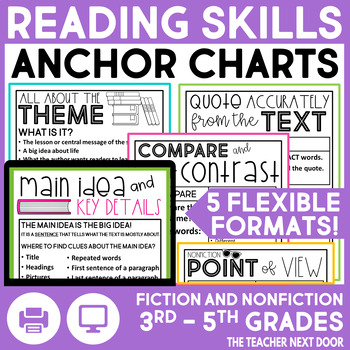Reading Skills Anchor Charts and Posters - Reading Skills for 3rd - 5th Grades
- PDF
- Google Apps™

What educators are saying
Also included in
- ⭐ EVERY GRAPHIC ORGANIZER AND ANCHOR CHART YOU'LL EVER NEED! ⭐ This bundle includes 63 Anchor Charts and 120 Graphic Organizers to cover ALL FICTION and NONFICTION reading standards for Grades 3, 4, and 5!You'll love the ready-to-use, NO PREP print and digital formats for these! In fact, there are 5Price $10.00Original Price $17.00Save $7.00
Description
Ever wish you had a ready-made anchor chart for every fiction and nonfiction reading standard? These 63 print and digital anchor charts are NO PREP and ready to go to make teaching reading so much easier!
Teaching reading can be challenging, but these reading skills anchor charts can help guide reading lessons to help you introduce and review reading comprehension concepts in a clear way. They can actually be used to guide lesson plans, saving you time! The benefits extend to students too, who will be able to use the anchor charts to better understand and organize reading concepts visually.
The anchor charts can be used for mini-lessons in Reading Workshop or Guided Reading, for strategy groups, for small group work, for reading conferences, for review, and intervention. They can also be glued into reading journals or reader's notebooks for student reference.
Please note: While the anchor charts are aligned to Common Core standards, the charts themselves have no notations and will work well with a number of other standards.
This resource includes:
27 Fiction Anchor Charts (in 5 formats)
36 Nonfiction Anchor Charts (in 5 formats)
Teacher Notes:
- LINKS
- How to Use This Resource
- List of All Reading Anchor Charts and their Common Core Standards
The Reading Skills Anchor Charts come in five formats to give you greater flexibility.
- Print - Full Page (for reading lessons or spiral-bound reading journals)
- Print - Half-Page (to glue into composition sized reader's notebooks)
- Print - Blank Templates (for notetaking)
- Digital - Full Page (Google Slides or PPT)
- Digital - Blank Templates (for notetaking)
Here are the reading skills covered:
Fiction (27 Anchor Charts) -
Ask and Answering Questions (3)
Retelling a Story
Finding the Central Message
Writing a Summary
All About the Theme
Describing Characters
Describing Settings and Events
Story Elements
Compare and Contrast
Context Clues
Literal and Nonliteral Word Meanings
Context Clues (Including Mythology)
Using Context Clues with Figurative Language
Stories, Dramas, and Poems
Poems, Drama, and Prose
Point of View (Perspective)
Point of View - first person and third person (2)
How Do Illustrations Add to the Text?
Connections Between the Text and a Presentation of the Text
Visual and Multimedia Elements With Text (2)
Compare and Contrast Books (3)
Nonfiction (36 Anchor Charts) -
Ask and Answer Questions Using Text
Refer to the Text to Support Your Answers
Quote Accurately From the Text
Main Idea and Key Details (2)
Two or More Main Ideas with Key Details
Writing a Nonfiction Summary (2)
Nonfiction Sequencing
Cause and Effect
Types of Informational Text
Inf. Text Cause and Effect Examples
Relationships Between Individuals, Events, Ideas
Context Clues (3)
Text Features (5)
Informational Text Structures (2)
Point of View: Nonfiction (Perspective)
NF Point of View (firsthand and secondhand account)
Point of View for the Same Event or Topic
How Do Illustrations Increase Understanding?
Visual, Oral, and Multimedia Information Adds to Nonfiction Text
Using Multiple Sources to Find Information Text
Make Logical Connections to Find Text Evidence
Text Evidence - Finding Proof: Reasons and Evidence (3)
Compare Two Nonfiction Texts
Combine Information From Two Texts
Integrate Information from Several Texts
Want to SAVE MORE and GET MORE??? You can grab the bundle with these anchor charts plus a set of 120 graphic organizers to take you through the entire year!
SAVE THE MOST and GET THE MOST with the Reading Workshop: The Complete Kit! This resource is included, plus yearlong framework materials like graphic organizers, question stems, reading conference forms, reader's notebook materials, and more! It also includes an entire month of mini-lessons about routines and expectations and reading comprehension strategies to launch your Reading Workshop successfully!
Why You'll Love This Resource:
- You'll have an anchor chart for EVERY fiction and nonfiction reading standard!
- The anchor chart posters can help guide reading lessons step-by-step using concise language.
- The reading anchor charts are easy to use with little to NO PREP! No more having to create your own anchor charts!
- The resource includes five formats to give busy teachers more flexibility.
- The anchor charts have no "cutesy" clip art images, so they can be used with older students for review or intervention.
- There are so many ways to use this resource, for guided reading and reader's workshop lessons, reading conferences, reader's notebooks or journals, review, intervention, and more!!!
Need more reading resources? I love using these reading centers. They're standards-aligned and lots of fun!
20 Reading Centers for 3rd Grade - Yearlong Bundle
20 Reading Centers for 4th/5th Grade - Yearlong Bundle
Finally, if you like my work, I would love for you to follow me by clicking on the green star at the top of the page.
Thanks!
Jenn
©The Teacher Next Door™
Purchasing this product grants permission for use by one teacher in his or her own classroom or for one homeschool parent teaching his/her child. If you would like to share with others, please purchase additional licenses.
This resource may only be placed on a password-protected website for your students, like Google Classroom™. It may not be placed anywhere else on the internet, on a class or school website visible to the public, or on a district server. Please email me if you have any questions: theteachernextdoor01@gmail.com.






